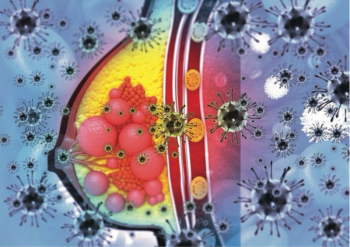
- ONCOLOGY Vol 12 No 8
- Volume 12
- Issue 8
Irinotecan: Toward Clinical End Points in Drug Development
The objective response rate is the initial method to assess the activity of a novel anticancer agent. Response rates may not characterize a new agent’s clinical benefit, however, especially if moderate to severe toxicity may be
ABSTRACT: The objective response rate is the initial method to assess the activity of a novel anticancer agent. Response rates may not characterize a new agents clinical benefit, however, especially if moderate to severe toxicity may be associated with treatment. Clinical end points, such as improvement in survival or relief of disease-related symptoms, provide clinicians with a more rational basis for selecting therapies. Irinotecan (CPT-11 [Camptosar]) was introduced into clinical practice based primarily on its consistent phase II activity (response rates of 13.3% to 21.7% in patients with advanced colorectal cancer refractory to 5-fluorouracil [5-FU]). Two recently presented, randomized, phase III trials have examined irinotecans impact on clinical end points of survival, quality of life, tolerability, and control of disease-related symptoms in 5-FU-refractory colorectal cancer patients. The first trial prospectively compared irinotecan and best supportive care (BSC) to BSC alone in patients with 5-FU-resistant metastatic colorectal cancer. Irinotecan-treated patients had significantly prolonged survival, improved quality of life, and better control of disease-related symptoms. The second trial compared irinotecan to infusional 5-FU schedules in colorectal cancer patients whose tumors had progressed within 3 months of prior 5-FU. Patients treated with irinotecan lived significantly longer than those given infusional 5-FU and had a comparable quality of life. These randomized trials demonstrate an evolution in our understanding of the clinical utility of irinotecan. [ONCOLOGY 12(Suppl 6):13-21, 1998]
The most commonly prescribed systemic treatment for advanced colorectal cancer is 5-fluorouracil (5-FU), usually administered with leucovorin. A recent meta-analysis of trials conducted in previously untreated colorectal cancer patients demonstrated an overall response rate of 23% with 5-FU-plus-leucovorin regimens and 11% with single-agent 5-FU; the addition of leucovorin to 5-FU also produced little improvement in survival duration.[1] Although 5-FU has been prescribed for the palliation of advanced colorectal cancer patients for almost 4 decades, little prospective information exists regarding the true palliative benefit of this agent and its amelioration of disease-related symptoms.
For patients whose disease has progressed during 5-FU therapy, no standard second-line treatment option existed until the availability of irinotecan (CPT-11 [Camptosar]) in 1996.[2] Irinotecan occupies a unique position in oncology therapy, being the only drug approved by the FDA for the treatment of 5-FU-refractory colorectal cancer patients.
Phase II trials in which patients were treated with irinotecan at a dose of 125 mg/m²/wk for 4 consecutive weeks every 6 weeks noted response rates of 20.8% (10/48; 95% confidence interval [CI], 9.3% to 32.3%) and 13.3% (12/90; 95% CI, 6.3% to 20.4%).[3,4] Japanese investigators administered irinotecan at doses of either 100 mg/m² weekly (without a rest period) or 150 mg/m² every 2 weeks and observed an overall response rate of 21.7% (10/46; 95% CI, 9.8% to 33.7%) in previously treated patients.[5] French investigators used 350 mg/m² of irinotecan every 3 weeks; their intent-to-treat analysis indicated a response rate of 15.6% (23/147; 95% CI, 10.1% to 22.5%).[6] Thus, the various schedules of irinotecan described above show comparable response rates.
In the FDA-reviewed pivotal trials, a 15% (29/193; 95% CI, 10.1% to 20.1%) response rate with a median response duration of 6 months was noted for patients treated at the recommended irinotecan dose of 125 mg/m²/wk for 4 weeks every 6 weeks.[2] Although the initial rationale for prescribing irinotecan was based primarily on the aforementioned phase II response rate data, these clinical trials also suggested that patients may derive benefit that may not be apparent when one solely examines response rates. In the FDA-reviewed trials, 49% of patients had a best response to treatment designated as "stable disease," often with tumor reductions that did not achieve the requisite definition of partial response. Decrements in serial carcinoembryonic antigen (CEA) determinations (mean 28% decrease in 79 stable disease patients) were observed. Palliative benefits of a decrease in pain were observed in 12 responding patients.[2]
Nevertheless, 30% of irinotecan-treated patients experienced grade 3 or 4 diarrhea, and 20% were hospitalized for the management of toxicity. Thus, an accurate depiction of irinotecans clinical benefit may be obscured by a relatively low objective response rate accompanied by a considerable, yet manageable, toxicity profile.
To more accurately define irinotecans clinical benefit in the treatment of refractory colorectal cancer, two randomized phase III trials that were presented at the 1998 American Society of Clinical Oncology (ASCO) meeting will be reviewed herein.[7,8] Rather than focusing on surrogate end points of response rate or time to progression, these two trials prospectively examined clinical end points--irinotecans effect on survival, quality of life, and amelioration of disease-related symptoms.
The first trial, conducted by Cunningham et al, was a prospective, nonblinded, multicenter, randomized phase III trial comparing irinotecan, 350 mg/m² as a 90-minute infusion every 3 weeks, to best supportive care (BSC) only.[7] Patients randomized to irinotecan also received BSC.
The sample size of the clinical trial was determined by a two-tailed log-rank test with an alpha risk of 0.05 and a power of 80%. Based on the hypothesis that the expected 1-year survival rate in the irinotecan arm would be 35% compared to 20% in the BSC arm, the sample size of the trial was determined to be 254 patients with a 2:1 randomization (176 patients to be treated with irinotecan and 88 with BSC).
To be eligible for the trial, patients were required to have histologically proven colorectal cancer, evidence of metastatic disease, and documented progression while receiving 5-FU or within 6 months after the last 5-FU infusion. In addition, patients were required to have a World Health Organization (WHO) performance status £ 2, no more than two prior 5-FU regimens for metastatic disease, and adequate hematologic, renal, and liver function. This study did not stratify patients for known prognostic variables (eg, performance status).
Patient Characteristics
A total of 279 patients were enrolled in the trial; 189 in the irinotecan arm and 90 in the BSC group. The two treatment groups had similar patient characteristics with regard to median age (59 years for the irinotecan group vs 62 years for the BSC group) and proportion of symptomatic patients (75% vs 83%). There was a statistically significant imbalance between the two groups, however, with respect to the known prognostic variable of performance status (Table 1).
As shown in Table 2, a similar percentage of patients was distributed between the irinotecan and BSC arms with respect to the location of the primary tumor (right/left colon vs rectum), number of organs involved (1, 2, ³ 3), and metastatic disease sites (liver, lung, peritoneum). In addition, the treatment arms were balanced with respect to prior surgery, prior radiation therapy, documented progression while on 5-FU therapy, and documented progression within 6 months of 5-FU therapy. The median time from progression on 5-FU to randomization was 1.0 months for both treatment groups. The median time from the last 5-FU infusion to randomization was 1.4 months for the irinotecan arm vs 1.6 months for the BSC arm.
Table 3 shows patient characteristics in terms of the number of prior 5-FU regimens, as well as the last schedule of 5-FU used. A similar number of patients in both groups (69% of patients treated with irinotecan and 75% of patients receiving BSC alone) had prior exposure to infusional schedules of 5-FU.
Results
With a median follow-up of 13 months, the median survival of irinotecan-treated patients was 9.2 months, as compared with a median survival of 6.5 months for the patients allocated to BSC alone (P = .0001, log-rank test; Figure 1). For the irinotecan arm vs the BSC-alone arm, the survival probability was 73% vs 54% at 6 months, 53% vs 29% at 9 months, and 36% vs 14% at 12 months (Figure 2).
Because of the imbalance in performance status between the two arms, a multivariate analysis was performed analyzing treatment effect on survival adjusted for prognostic factors. After stratification for performance status, the survival benefit for the irinotecan arm remained statistically significant (P = .001), with an increased death risk ratio of 1.71 in the BSC arm (Figure 3 and Figure 4).
As shown in Figure 5, an analysis of survival without performance status deterioration showed a statistically superior median survival without deterioration in patients allocated to the irinotecan arm compared to those in the BSC arm (5.7 vs 3.3 months; P < .001); the irinotecan group also fared better with respect to survival without weight loss > 5% (P = .018). As illustrated in Figure 6, median pain-free survival was superior in patients randomized to irinotecan treatment vs BSC alone (6.9 vs 2.0 months; P = .003).
Rates of grade 3-4 adverse effects were consistent with those previously published for irinotecan.[2-5] These included neutropenia (22%), neutropenia associated with fever or infection (3%), infection without neutropenia (9%), diarrhea (22%), vomiting (14%), asthenia (15%), mucositis (2%), and drug-related deaths (1%). A higher percentage of patients in the BSC arm than in the irinotecan arm experienced grade 3-4 asthenia (19% vs 15%). Rates of other grade 3-4 adverse events experienced in the BSC-alone arm included diarrhea (6%), vomiting (8%), and nonneutropenic infections (3%).
Quality of life was assessed using the European Organization for Research and Treatment of Cancer (EORTC) Quality of Life C30 (QLQ-C30) instrument. Compared to patients who received BSC alone, patients treated with irinotecan had improved scores for physical (P < .001), role (P = .002), cognitive (P = .006), and social (P = .006) functioning.
An analysis of the QLQ-C30 compared the worst patient scores during the study in the two treatment groups. Specific patient scores examined included asthenia, nausea/vomiting, pain, dyspnea, sleep disturbance, appetite loss, constipation, diarrhea, and financial impact. There was no statistical difference between the treatments with regard to nausea/vomiting and sleep disturbance; diarrhea was rated higher for the irinotecan-treated arm. All other parameters (asthenia, pain, dyspnea, appetite loss, constipation, and financial impact) indicated a favorable effect of irinotecan.
The investigators concluded that irinotecan significantly prolongs survival, as well as improves quality of life and control of tumor-related symptoms in patients with 5-FU-refractory colon cancer. Based on these results, the investigators stated that irinotecan should be considered the new standard of care for this patient population.
A second prospective, nonblinded, multicenter, randomized phase III trial reported by Van Cutsem et al at ASCO compared irinotecan as second-line chemotherapy to 5-FU-based chemotherapy.[8,9] The primary end point of this trial was a comparison of overall survival; secondary end points included comparisons of progression-free survival, symptom-free survival, quality of life/clinical benefit, and adverse events. Patients with advanced colorectal cancer were allocated either to irinotecan, 350 mg/m² as a 90-minute infusion every 3 weeks, or to one of three infusional regimens shown in Table 4.[10-12]
The sample size determination was based on a two-tailed log-rank test with an alpha risk of 0.05 and a power of 80%. The hypothesis examined the difference in the 1-year survival rate with an expected rate in the irinotecan arm of 35% and an assumed rate in the 5-FU arm of 20%. The projected enrollment was 258 patients (129 per treatment).
The eligibility criteria for the study included histologically proven colorectal cancer, metastatic disease, WHO performance status £ 2, documented progression (either on radiographic imaging or increasing CEA) while receiving 5-FU therapy at optimal dose (defined as dose intensity ³ 400 mg/m²/wk) or within 3 months after the last 5-FU infusion. Patients were excluded if they had received more than one palliative 5-FU regimen or had bulky disease.
The study randomized a total of 267 patients, 133 to the irinotecan arm and 134 to the 5-FU arms. A total of 127 patients randomized to irinotecan actually received their assigned treatment, and 129 randomized to one of the 5-FU arms actually received their assigned regimen (7 of them received subsequent treatment with irinotecan). Of those receiving to 5-FU therapy, 27%, 30%, and 43% were assigned to the three respective treatment regimens outlined in Table 4.
Patient Characteristics
Patient characteristics were balanced between the irinotecan and 5-FU regimens with respect to median age, performance status, number of symptomatic patients, prior surgery or radiotherapy, and median time from progression to randomization (0.9 months in both groups). With respect to prior 5-FU treatment, the number of patients who received adjuvant therapy only was similar for the irinotecan and 5-FU regimens (13% vs 15%), as was the number of patients who received infusional 5-FU as their last prior treatment (34% vs 38%).
Results
With a median follow-up of 15 months, the overall survival of patients treated with irinotecan was 10.8 months, as compared with 8.5 months for the 5-FU-treated patients (P = .04; see Figure 7). Survival at 1 year was 1.4 times greater for irinotecan recipients than for their counterparts receiving 5-FU (Figure 8). In addition, survival adjusted for prognostic factors remained significantly improved in the irinotecan group (P = .029). Progression-free survival was also significantly better in patients allocated to irinotecan treatment (P = .002).
An analysis of survival without symptoms (including anorexia, constipation, diarrhea, fever, hemorrhage, nausea, vomiting, and pain) noted a median symptom-free survival of 8.1 months for those treated with irinotecan, as compared with 7.0 months for those allocated to the 5-FU regimens (P = .23). Median pain-free survival was 10.3 and 8.5 months (P = .06) for the irinotecan and 5-FU regimens, respectively. The median survival without performance status deterioration was 6.4 vs 5.1 months for the irinotecan vs 5-FU arms (P = .18), and median survival without weight loss was 8.9 vs 7.4 months (P = .23).
Adverse events reported with the two treatments are summarized in Table 5 and Table 6. As expected for the grade 3 and 4 toxicities previously reported for these regimens, neutropenia was observed more frequently in patients receiving irinotecan than in those given the infusional 5-FU regimens (14% vs 2%); diarrhea also was more common in the irinotecan than in the 5-FU groups (22% vs 11%). Cutaneous toxic effects (ie, hand-foot syndrome) were more common with the infusional 5-FU treatments (1% vs 8%). Asthenia occurred with a similar frequency in patients treated with irinotecan or 5-FU (13% vs 12%).
The EORTC QLC-C30 questionnaire was used at baseline, at the visit for administration of second treatment, and at 6- to 8- week intervals to assess quality of life.[9] Univariate analysis of the quality-of-life data disclosed that changes from baseline of the global heath status score were similar in the 5-FU and irinotecan groups, with the exception that scores for diarrhea and nausea/vomiting were better for the 5-FU-treated patients than the for irinotecan-treated patients. Evolution of fatigue was similar with the two treatments.
A comparison of medical care consumption (excluding hospitalization for chemotherapy administration) in the irinotecan and 5-FU groups revealed similar mean length of hospital stay (10 vs 14 days), mean length of time spent in hospital (1.5 vs 1.8 days/patient/month), and percentage of time spent in hospital in 1 year (5% vs 6%).
The investigators concluded that metastatic colorectal patients treated with irinotecan live significantly longer than those treated with infusional 5-FU and that quality-of-life parameters in the two groups are comparable.
The trials described above demonstrated irinotecans ability to prolong survival in patients with metastatic colorectal cancer refractory to 5-FU compared to patients receiving BSC alone or infusional regimens of 5-FU. The dose schedule used in these trials (every 3-week schedule) was irinotecan 350 mg/m² once every 3 weeks (or 300 mg/m² once every 3 weeks if patients were ³ 70 years or had a WHO performance status of 2).[13,14] This dosing schedule of irinotecan is not commonly used in the United States, where the FDA-approved schedule (weekly × 4) is 125 mg/m² every week for 4 weeks followed by a 2-week rest. In both the every 3-week and weekly × 4 schedules, irinotecan is administered as a 90-minute infusion.
Direct comparison of the two dose schedules of irinotecan is difficult since they have not been compared directly in a randomized trial. Table 7 summarizes the efficacy data of seven trials of irinotecan; Table 8 provides a comparison of adverse events associated with these two dose-schedules. In all of these trials, patients had received prior 5-FU, with the last 5-FU regimen administered for the treatment of metastatic disease in the majority of patients in each trial (65% to 89%).
Most patients receiving the every 3-week regimen were allowed to have prior irradiation (13.1% to 37%), whereas pelvic irradiation was generally excluded in patients treated with the weekly × 4 schedule, with the exception of one trial in which 29% of patients received abdominal/pelvic radiotherapy. Collective results of these phase II and III trials of irinotecan in patients with similar demographics suggest similar efficacy and adverse-effect profiles of these two schedules.
When evaluating all of the seven trials, no obvious pattern was observed with regard to efficacy (response rate, median time to progression, or survival) between the weekly × 4 schedule and the every 3-week schedule. Response rates were similar among the trials and were reported only in the phase II trials. Response rates ranged from 12.1% to 20.5%; median time to progression ranged from 3.5 to 5.1 months.
When evaluating median survival or 1-year survival no clear pattern was observed in median or 1-year survival rates based on irinotecan dose regimen. Median survival ranged from 7.7 to 10.7 months and percentage of patients alive at 1-year varied from 31.1% to 44.8%.
Late grade 3-4 diarrhea was noted in 32.8% to 38.5% of patients enrolled in early trials of the weekly ´ 4 schedule. The frequency of grade 3-4 diarrhea appeared to be reduced in later trials of the every 3-week schedule (22% to 26%). This reduction was also observed in a later trial of the weekly ´ 4 schedule, which reported a 24.8% incidence of grade 3-4 diarrhea.[15] This reduction in grade 3-4 diarrhea in subsequent trials was attributed to greater adherence to dose-modification schedules and use of loperamide by investigators.
Clear differences in grade 3-4 neutropenia based on the irinotecan dose regimen were not apparent, with approx- imately one-fourth to one-third of patients experiencing this toxic effect. Except for a single trial noting a 15.5% rate of neutropenic fever, this complication was observed in less than 8% of patients. Treatment-related deaths were uncommon in all of the trials.
The cholinergic syndrome associated with irinotecan may be more common when the drug is administered on the every 3-week schedule. Small doses of intravenous or subcutaneous atropine either prevent or readily manage this toxic effect, however.
Although irinotecan entered clinical practice based on phase II trials demonstrating reproducible activity in 5-FU-refractory colorectal cancer patients, phase III randomized trials have clarified its clinical benefits in prolonging survival and ameliorating disease-related symptoms. In the trial comparing irinotecan to BSC, a 1-year survival rate of 36% was observed in patients treated with irinotecan, as compared with a 14% survival rate in patients randomized to BSC. Median survival, survival without performance status deterioration, and pain-free survival were also statistically superior in patients allocated to receive irinotecan.
In the second trial, 45% of patients receiving irinotecan were alive at 1-year, compared to 32% receiving infusional 5-FU. This trial also demonstrated an improvement in median survival associated with irinotecan. Comparable quality-of-life parameters were observed with irinotecan or infusional 5-FU regimens.
Although these randomized trials used a 3-week dose schedule of irinotecan, similar efficacy and adverse effect profiles are apparent when one compares the results of trials of irinotecan using either a 3-week or weekly × 4 dose schedule.
References:
1. Advanced Colorectal Cancer Meta-Analysis Project: Modulation of fluorouracil by leucovorin in patients with advanced colorectal cancer: Evidence in terms of response rate. J Clin Oncol 10:896-903, 1992.
2. Von Hoff DD, Rothenberg ML, Pitot HC, et al: Irinotecan (CPT-11) therapy for patients with previously treated metastatic colorectal cancer: Overall results of FDA-reviewed pivotal US clinical trials (abstract). Proc Am Soc Clin Oncol 16:228a, 1997.
3. Rothenberg ML, Eckardt JR, Kuhn JG, et al: Phase II trial of irinotecan in patients with progressive or rapidly recurrent colorectal cancer. J Clin Oncol 14:1128-1135, 1996.
4. Pitot HC, Wender DB, OConnell MJ, et al: Phase II study of irinotecan in patients with metastatic colorectal cancer. J Clin Oncol 15:2910-2919, 1997.
5. Shimada Y, Yoshino M, Wakui A, et al: Phase II study of CPT-11, a new camptothecin derivative, in metastatic colorectal cancer. J Clin Oncol 11:909-913, 1993.
6. Rougier P, Bugat R, Douillard JY, et al: Phase II study of irinotecan in the treatment of advanced colorectal cancer in chemotherapy-naive patients and patients pretreated with fluorouracil-based chemotherapy. J Clin Oncol 15:251-260, 1997.
7. Cunningham D, Pyrhonen S, James RD, et al: A phase III multicenter randomized study of CPT-11 vs supportive care alone in patients with 5FU-resistant metastatic colorectal cancer (abstract). Proc Am Soc Clin Oncol 17:1a, 1998.
8. Van Cutsem E, Bajetta E, Niederle N, et al: A phase III multicenter randomized trial comparing CPT-11 to infusional 5-FU regimen in patients with advanced colorectal cancer after 5-FU failure (abstract). Proc Am Soc Clin Oncol 17:256a, 1998.
9. Blijham GH, Mesbah M, Glimelius B, et al: Quality of life (QOL) evaluation of CPT-11 compared to best supportive care or infusional 5-FU in patients with 5-FU resistant advanced colorectal cancer (abstract). Proc Am Soc Clin Oncol 17:413a, 1998.
10. de Gramont A, Bosset JF, Milan C, et al: Randomized trial comparing monthly low-dose leucovorin and fluorouracil bolus with bimonthly high-dose leucovorin and fluorouracil bolus plus continuous infusion for advanced colorectal cancer: A French intergroup study. J Clin Oncol 15(2):808-815, 1997.
11. Lokich JJ, Ahlgren JD, Gullo JJ, et al: A prospective randomized comparison of continuous fluorouracil with a conventional bolus schedule in metastatic colorectal carcinoma: A Mid-Atlantic Oncology Program Study. J Clin Oncol 11:1888-1893, 1993.
12. Köhne CH, Schöfski P, Wilke H, et al: Biochemical modulation of weekly high-dose infusional (HD-CI) 5-FU in patients with advanced colorectal cancer. Results of a multicenter randomized AIO trial (abstract). Am Soc Clin Oncol 16:271a, 1997.
13. Abigerges D, Chabot GG, Armand J-P, et al: Phase I and pharmacokinetic studies of camptothecin analog irinotecan administered every 3 weeks in cancer patients. J Clin Oncol 13:210-21, 1995.
14. Armand J-P, Ducreux M, Mahjoubi M, et al: CPT-11 in the treatment of colorectal cancer. Eur J Cancer 31:1283-87,1995.
15. Pazdur R, Zinner R, Rothenberg ML, et al: Age as a risk factor in irinotecan treatment of 5-FU refractory colorectal cancer (abstract). Proc Am Soc Clin Oncol 16:260a, 1997.
Articles in this issue
over 27 years ago
CD-ROM Helps Cancer Patients Ease the Painover 27 years ago
UT Southwestern and Komen Foundation Offer Breast Care Fellowshipover 27 years ago
Controversies in the Management of Stage I Seminomaover 27 years ago
Genetic Switch May Yield Map of Prostate Cancer Machineryover 27 years ago
Personalized Approach Increases Breast Cancer Screening RatesNewsletter
Stay up to date on recent advances in the multidisciplinary approach to cancer.

















































































